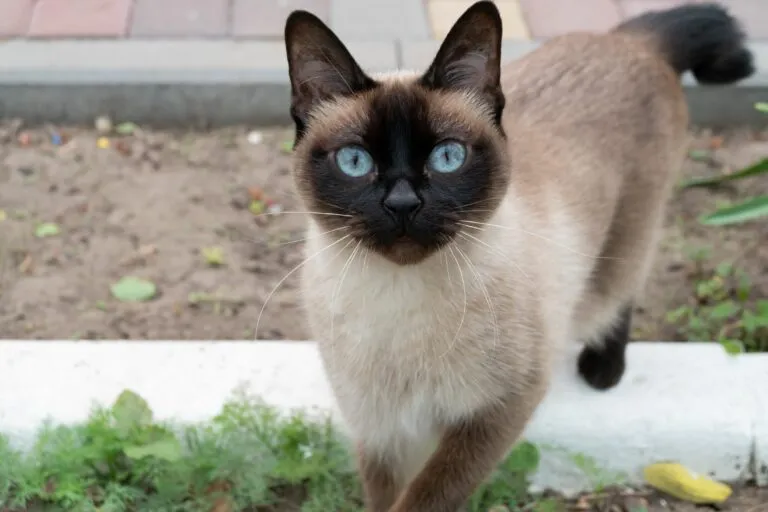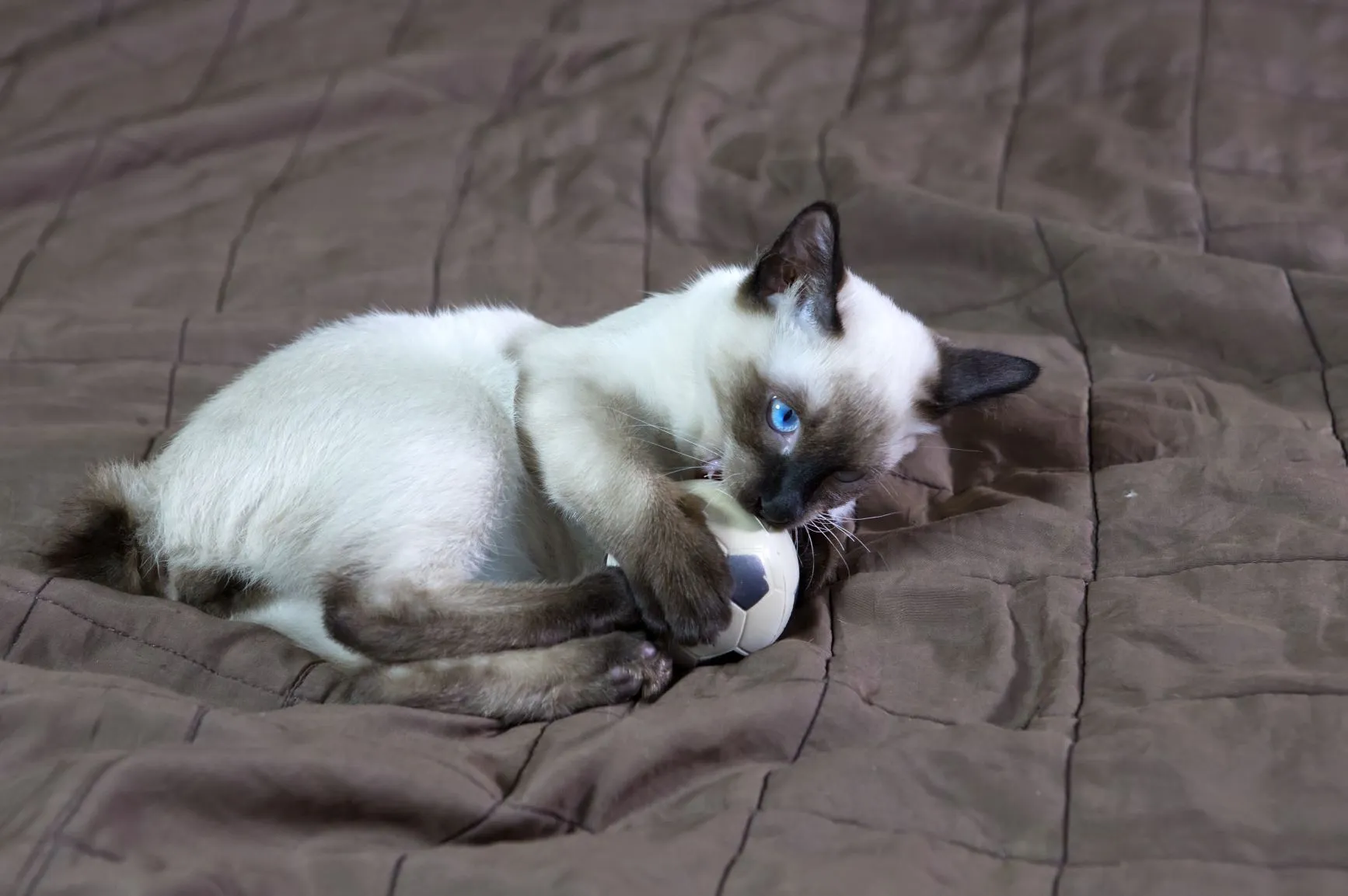Maine Coon
The Maine Coon has now become one of the most popular cat breeds in the world and is enjoying increasing popularity in Ireland, too. This is probably thanks to its authenticity, robustness and excellent character.
The Mekong Bobtail is a relatively rare cat breed that originally comes from Asia. Its short stumpy tail and point marking are typical features of the Mekong Bobtail.

© Елена Лихацкая / stock.adobe.com
Typical Mekong Bobtail: Stumpy tail and point markings.
If it wasn’t for the short tail, the Mekong Bobtail could easily be mistaken for a Siamese. Both are shorthair breeds and have light body fur with a point pattern.
Mekong Bobtails weigh on average between 3.6 and 4.5 kilograms, therefore are medium-sized cats. Their physique is muscular, but still slender and elegant. The legs are of medium length.
The short, kinked tail is typical of this rare cat breed. According to the standard of the World Cat Federation, the tail should have at least three vertebra. However, its length must not exceed one quarter of the body length.
The Mekong Bobtail’s fur is short and shiny with little undercoat. Mekong Bobtails can also be recognised by their striking fur colour with typical point markings.
What is meant by point markings? Point cats have light body fur, whilst the snout, ears, legs and tail are darker in colour.
A hereditary metabolic disorder is responsible for the striking colour combination: The enzyme tyrosinase, which is required for melanin production, only functions at colder temperatures. However, melanin is needed to make the fur dark.
In point cats, the dark colouring only works on the cooler outer parts of the body, i.e. the points. The fur remains light in the middle where the body is warmer (partial albinism). These cats are fully white shortly after the birth, because it is so warm in the uterus that no melanin is formed.
Siamese cats, Birman cats (Sacred Birman), Thai cats, Ragdolls and the Balinese are cat breeds with a point pattern.
The Mekong Bobtail’s large oval eyes are an intense blue. This is something else they have in common with other point cats, such as the Siamese.
Cats of this breed are described as alert, curious and playful. However, these intelligent felines need plenty of attention – and sufficient activity. If they are bored, they can meow extensively. Like the Siamese, Mekong Bobtails are also relatively chatty.
Hence, you definitely should take time for regular play sessions and offer your cat interesting scratching and climbing options. Maybe you can even get your Mekong Bobtail interested in clicker training.
You can keep these agile exotic cats occupied by themselves for a while with intelligence toys.
 © Konstantin Kulikov / stock.adobe.com
© Konstantin Kulikov / stock.adobe.com
These cats are relatively low-maintenance and aren’t particularly demanding for their owners. Since it is a shorthair breed, you only need to brush the fur occasionally – especially in spring and autumn during the moulting period.
You should of course also pay attention to such basic things as high-quality food and suitable litter boxes with a Mekong Bobtail so that it feels at ease with you.
Mekong Bobtails can be kept as outdoor cats, but also feel at ease indoors. A balcony with safety mesh or a secured garden are ideal.
Mekong Bobtails make excellent family cats with their friendly, affectionate nature. They are said to get on particularly well with children.
These stump-tailed cats are sociable, so if possible you should take two of them into your home. They should also get on well with other pets.
Certain hereditary diseases are particularly common with Mekong Bobtails. These include, for instance, ocular ailments like nystagmus or watery eyes. Hence, you should regularly check your Mekong Bobtail’s eyes and immediately see a vet if there are any changes.
Members of this cat breed are also prone to mammary tumours and other cancers. Diseases of the urinary tract and digestive system aren’t uncommon either.
The fact that Mekong Bobtails have a very short and kinked tail could too lead to health problems. Cats need their tail to maintain their balance when climbing. Moreover, the tail is an important means of communication. Cats without a tail are limited in their communication.
Tailless breeds like Manx cats have severe damage to the spine and can be classed as torture breeding. Experts consider it possible that Mekong Bobtails with their stumpy tail also suffer from spinal problems.
Despite these limitations, the life expectancy of a Mekong Bobtail is quite high at around 15 to 18 years of age.
Mekong Bobtails are extremely rare and therefore difficult to get. Breeders are more likely to be found in Russia.
Even if you like this breed because of its loving character traits, you should refrain from making a purchase. By encouraging demand, you are promoting the planned breeding of cats with severe health limitations. You may strike lucky in an animal shelter – every now and then even pedigree cats end up in animal shelters.
Definitely steer clear of breeders offering stumpy-tailed cats at bargain prices! They are generally unscrupulous breeders focused on quantity over quality who are solely concerned with making a quick buck. Cats usually aren’t kept in a species-appropriate manner, don’t have proper paperwork and are neither vaccinated nor dewormed.
Mekong Bobtails originate from Thailand. The assumption is that it is descended from Siamese cats. The breed owes its name to the Mekong River, which flows through Thailand and other countries. Sometimes the breed is also called the Thai tailless.
This unusual cat breed is relatively widespread in Asia. Mekong Bobtails also have a community of fans in Russia, and there is an interesting story behind this:
In the 19th century, the King of Siam (now Thailand) is said to have given the Russian Tsar Nikolai II around 200 cats as a gift. Most of them had a stumpy tail. Even today, this breed is bred mostly in Russia.
Other stumpy-tailed cat breeds are the Japanese Bobtail, Kurilian Bobtail and Pixie-bob.
Mekong Bobtails are extremely loveable cats: Intelligent, affectionate and particularly well-suited to families with children. On these shores, this breed has rarity value – which is perhaps a good thing, since members of this breed are prone to numerous health problems.
The Maine Coon has now become one of the most popular cat breeds in the world and is enjoying increasing popularity in Ireland, too. This is probably thanks to its authenticity, robustness and excellent character.
Neva Masquerade – a mysterious name for a mysterious thing of beauty! The Neva Masquerade is the point variation on the Siberian cat and shares many characteristics with this breed.